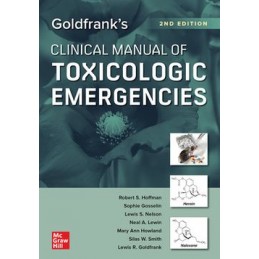- Obniżka


 Dostawa
Dostawa
Wybierz Paczkomat Inpost, Orlen Paczkę, DHL, DPD, Pocztę, email (dla ebooków). Kliknij po więcej
 Płatność
Płatność
Zapłać szybkim przelewem, kartą płatniczą lub za pobraniem. Kliknij po więcej szczegółów
 Zwroty
Zwroty
Jeżeli jesteś konsumentem możesz zwrócić towar w ciągu 14 dni*. Kliknij po więcej szczegółów
Derived from the definitive guide to medical toxicology, this hands-on companion provides accurate information for diagnosing and treating poisoned patients on the spot
A Doodys Core Title for 2024!
After more than a decade on the market, Goldfranks Toxicologic Emergencies has established itself as the go-to reference for medical toxicology—and this companion manual distills the most important information into a portable, easy-to-navigate resource.
Goldfranks Manual of Toxicologic Emergencies distills critical information into short summaries and synopses, so you can use it to treat patients in clinical settings or for quick review of critical topics. Fully updated to ensure all information is completely current, this new edition is filled with tables, figures, images, and other visuals to make finding the right answers quick and easy. Each chapter is a direct distillation of the corresponding chapter in Goldfranks Toxicologic Emergencies.
Whether youre a medical toxicologist, pharmacist, physician, nurse practitioner, or student, Goldfranks Manual of Toxicologic Emergencies provides all the right answers where and when you need them.
Covers the full range of xenobiotics::
Opis
The table of contents (below) will mirror the main text, both for completeness and ease of cross-referencing.
Historical Principles and Perspectives
Toxicologic Misfortunes and Catastrophes in History
PART A
THE GENERAL APPROACH TO THE PATIENT
Initial Evaluation of the Patient: Vital Signs and Toxic Syndromes
Principles of Managing the Acutely Poisoned or Overdosed Patient
SC1. Principles of Antidote Stocking
Decontamination Principles: Prevention of Gastrointestinal Absorption
,serif;>,serif;>,serif;>,serif;>,serif;>,serif;>,serif;>,serif;>,serif;>,serif;>,serif;>,serif;>,serif;>,serif;>
SC2. Decontamination Principles: Prevention of Dermal, ophthalmic and inhalational Absorption
A1. Activated Charcoal
A2. Whole-Bowel Irrigation and Other Intestinal Evacuants
Principles and Techniques Applied to Enhance Elimination
,serif;>Indeks: 61861
Autor: Andres Martin
Indeks: 17487
Autor: Wojciech Leppert
Indeks: 19053
Autor: Zeng Shengping
Studia przypadków według tradycyjnej medycyny chińskiej
Indeks: 19054
Autor: Baiyan Liu
Studia przypadków według tradycyjnej medycyny chińskiej
